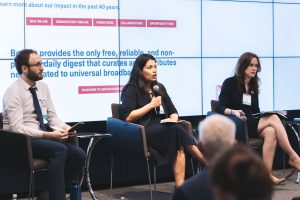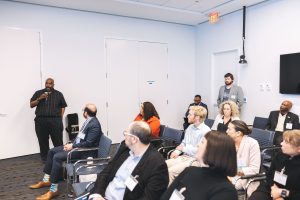By Stacey Baxter

Next Century Cities hosts the annual Bipartisan Tech conference to bring together local leaders and advocates in broadband access and adoption. This year, the annual event brought back in-person collaboration as attendees from across the country joined together in Washington, DC for a day centered around equity, access, and partnership. ![]()
The overarching theme of this year’s conference was the importance of storytelling and its unique impact on closing the digital divide through legislative change. The afternoon panel paid direct homage to prioritizing the role that storytelling has in closing the digital divide with specialized advice from three field experts in crafting the art of storytelling – Revati Prasad and Drew Garner from the Benton Institute for Broadband & Society and Nat Purser from Public Knowledge.
Revati launched the conversation by distinguishing between digital equity plans and the impact of storytelling. Storytelling, she explained, is a co-creation of voices that capture a deeper level of understanding than state plans can outline. It is a form of qualitative data that is incredibly valuable in informing lawmakers about issues that are contributing to the digital divide. Unlike quantitative data, this form of data elicits human connection and has an impact on decision-making.  Nat Purser used her expertise to share how storytelling compliments the work of advocates on The Hill, like herself. Nat used the term “collaborative storytelling” to share about the symbiotic relationship between community advocates, digital navigators, and Hill lobbyists. The stories that are shared by community advocates of individuals’ struggles to maintain broadband service are taken to lawmakers to highlight the need for legislative change, for example around continued funding for the Affordable Connectivity Program (“ACP”).
Nat Purser used her expertise to share how storytelling compliments the work of advocates on The Hill, like herself. Nat used the term “collaborative storytelling” to share about the symbiotic relationship between community advocates, digital navigators, and Hill lobbyists. The stories that are shared by community advocates of individuals’ struggles to maintain broadband service are taken to lawmakers to highlight the need for legislative change, for example around continued funding for the Affordable Connectivity Program (“ACP”).
Drew Garner brought the discussion full circle by sharing storytelling strategies and best practices for engaging lawmakers with collected stories. Drew gave the following suggestions for allowing data to be a form of storytelling, for both quantitative and qualitative findings.
Quantitative Data
-
Understandable content
-
Accessible data
-
Timely and up-to-date
-
Localized
-
Boil information down to a members
Qualitative Data
-
Emotionally resonant
-
Relevant subjects
-
Quotes and pictures
-
Maintain connection with community
-
Memorable nugget
Something that distinguished the storytelling panel from those earlier in the day was the invitation for conference attendees to take the microphone and practice sharing impactful stories. Several local advocates embraced the opportunity to share what they had learned and tell a story that could impact lawmakers.
One of the most influential stories came from William Honablew Jr., the Digital Equity Coordinator from the City of Baltimore. William told a story about a woman who he met at a ACP registration event in collaboration with the public housing authority. It is a part of their best practices that they do not make assumptions about the needs of the community, so when asking individuals “What do you need?”, “How is the digital divide affecting you?” William heard about how a stroke completely changed a woman’s life, making it almost impossible for her to use her cell phone and creating an Internet-dependent atmosphere due to her medically-necessary home devices. William set her up with a stylus pen and this small functional solution allowed her to use her cell phone independently, and was able to help register her for the ACP subsidy. Maintaining Internet access very truthfully sustains her quality of life post-stroke. Human life is too important to allow the ACP to lapse.
The digital divide affects more than just Internet access. In today’s society, not having access to the Internet can literally be a life or death situation. It is imperative that lawmakers understand the gravity of their decisions and have a true understanding of the realities that Americans are facing when it comes to affordable and reliable broadband access. And there is no better way to share these realities than through the art of storytelling.

